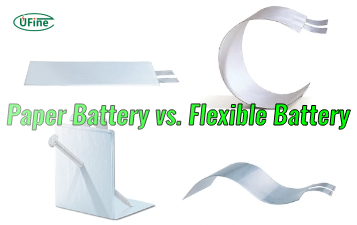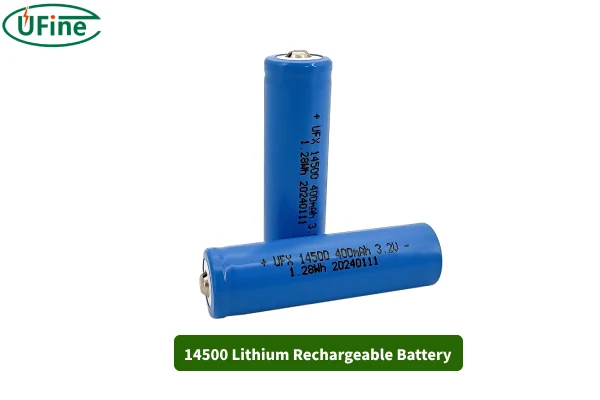Have you ever found yourself frustrated with constantly replacing batteries in your favorite devices? If so, you’re not alone. That’s where the 14500 lithium rechargeable battery comes into play. These batteries are not only reusable but also pack a punch with their high energy density. In this comprehensive guide, we’ll dive deep into what makes the 14500 lithium rechargeable battery so special. From their chemical compositions to their practical applications, we’ve got you covered. So, let’s jump right in and explore the world of 14500 lithium rechargeable batteries!
Part 1. What is a 14500 lithium rechargeable battery?
You might be wondering, “What exactly is a 14500 lithium rechargeable battery?” Well, let’s break it down. The 14500 battery is a cylindrical lithium-ion battery that’s roughly the same size as a standard AA battery. However, don’t let its size fool you. This tiny powerhouse boasts a higher voltage and capacity, which means it can deliver more energy and last longer between charges.
One of the best things about the 14500 battery is its rechargeability. Unlike single-use batteries, you can use these multiple times, which is not only cost-effective but also environmentally friendly. By reducing the number of disposable batteries you use, you’re contributing to a greener planet. Plus, the convenience of not having to constantly buy new batteries is a game-changer.
Part 2. 14500 battery types
Not all 14500 batteries are created equal. They come in several types, each with different chemical compositions. Understanding these differences can help you choose the right battery for your specific needs. Here are the most common types:
- Lithium-Ion (Li-ion): This is the most common type of 14500 battery. It has a high energy density and a nominal voltage of 3.6V to 3.7V. Li-ion batteries are known for their efficiency and long cycle life, making them a popular choice for many devices.
- Lithium Iron Phosphate (LiFePO4): These batteries are prized for their safety and stability. They have a nominal voltage of around 3.2V and are less prone to overheating and thermal runaway compared to other lithium-ion batteries. This makes them an excellent choice for devices where safety is a top concern.
- Lithium Manganese Oxide (LiMn2O4): LiMn2O4 batteries offer high thermal stability and safety, with a nominal voltage of 3.7V. They are often used in high-drain applications due to their ability to deliver high currents.
Each type of 14500 battery has its own set of advantages and is suitable for different applications. For instance, if you need a battery for a high-drain device like a flashlight, a LiMn2O4 battery might be your best bet. On the other hand, if safety is your primary concern, a LiFePO4 battery would be a wise choice.
Part 3. Size
Now, let’s talk about size. The 14500 lithium rechargeable battery is standardized in terms of its dimensions. Here’s a quick look at its size:
- Diameter: 14mm
- Length: 50mm
These dimensions make it almost identical in size to a standard AA battery. However, despite the similar size, the 14500 battery packs a lot more power. This makes it a versatile option for many devices that typically use AA batteries, provided they can handle the higher voltage.
Part 4. Voltage
Voltage is a crucial factor when it comes to batteries. The 14500 lithium rechargeable battery typically has a nominal voltage of 3.6V to 3.7V. This is significantly higher than the 1.5V you get from a standard AA battery.
Why does this matter? Well, the higher voltage means that the 14500 battery can deliver more power, making it ideal for high-drain devices. If you’re using a device that requires a lot of energy to operate efficiently, such as a high-powered flashlight or a vaporizer, the 14500 battery is a great choice. However, it’s essential to ensure that your device is compatible with the higher voltage to avoid any damage.
Part 5. Capacity
When we talk about battery capacity, we’re referring to how much energy a battery can store. This is measured in milliampere-hours (mAh). For 14500 lithium rechargeable batteries, common capacities range from 600mAh to 1000mAh.
A higher capacity means the battery can store more energy, allowing your device to run longer before needing a recharge. For example, if you’re using a flashlight with a 14500 battery that has a capacity of 1000mAh, it will last longer than if you were using a battery with a capacity of 600mAh. This can be particularly important for devices that you rely on for extended periods, such as portable electronics or emergency kits.
Part 6. Charger
To keep your 14500 lithium rechargeable batteries ready to go, you’ll need a compatible charger. There are several great options available, each with its own set of features. Here are a few popular choices:
- Nitecore i2 Intellicharger: This is a versatile charger that can handle different types of batteries, including 14500. It’s known for its reliability and ease of use, making it a popular choice among battery enthusiasts.
- XTAR VC2: The XTAR VC2 is a smart charger with a display that shows the charging status. It’s compatible with 14500 batteries and offers a range of safety features to ensure your batteries are charged safely.
- LiitoKala Lii-100: If you’re looking for a compact and affordable charger, the LiitoKala Lii-100 is a great option. It’s small enough to take with you on the go and can charge 14500 batteries efficiently.
Using the right charger is crucial for maintaining the health and longevity of your batteries. It’s always a good idea to invest in a quality charger to ensure your batteries are charged safely and efficiently.
Part 7. Application
The 14500 lithium rechargeable battery is incredibly versatile and is used in a wide range of applications. Here are some common uses:
- Flashlights: Thanks to their high energy density, 14500 batteries are perfect for high-powered flashlights. They provide the necessary power to keep your flashlight bright and reliable.
- Vaporizers: Many vaporizers use 14500 batteries because of their high power output. This ensures that the vaporizer can produce consistent and efficient performance.
- Portable Electronics: Devices like cameras, handheld game consoles, and digital recorders often use 14500 batteries. Their high capacity and rechargeability make them ideal for these types of devices.
- DIY Projects: Many hobbyists and DIY enthusiasts use 14500 batteries in their projects. Whether you’re building a custom flashlight or a remote-controlled car, these batteries offer the power and reliability you need.
- Emergency Kits: 14500 batteries are a great addition to emergency kits. Their long shelf life and reliability ensure that you have a dependable power source when you need it most.
The versatility of the 14500 battery makes it a popular choice for a wide range of applications. No matter what device you’re using, there’s a good chance a 14500 battery can power it effectively.
Part 8. How long is the life of the 14500 lithium rechargeable battery?
One of the most common questions about rechargeable batteries is, “How long do they last?” The lifespan of a 14500 lithium rechargeable battery depends on several factors, including usage patterns and charging habits. On average, these batteries can last between 300 to 500 charge cycles.
To get the most out of your 14500 batteries, it’s important to take good care of them. Here are a few tips to extend their lifespan:
- Avoid Overcharging: Overcharging can damage the battery and reduce its lifespan. Make sure to use a charger with overcharge protection to prevent this.
- Store Properly: When not in use, store your batteries in a cool, dry place. Extreme temperatures can negatively impact their performance and lifespan.
- Regular Use: Batteries that are used regularly tend to last longer than those that are left unused for long periods. If you have spare batteries, try to rotate them to ensure they all get regular use.
- Proper Charging Habits: Avoid letting your batteries drain completely before recharging. Lithium-ion batteries perform best when they’re kept between 20% and 80% charged.
By following these tips, you can maximize the lifespan of your 14500 lithium rechargeable batteries and get the most value out of your investment.
Part 9. 14500 lithium rechargeable battery VS. AA battery
Now, let’s compare the 14500 lithium rechargeable battery with a standard AA battery. While they may look similar, there are several key differences to consider:
- Voltage: The 14500 battery has a nominal voltage of 3.6V to 3.7V, while AA batteries have a nominal voltage of 1.5V. This higher voltage allows the 14500 battery to deliver more power, making it suitable for high-drain devices.
- Rechargeability: One of the biggest differences is that 14500 batteries are rechargeable, whereas standard AA batteries are typically single-use. This makes 14500 batteries a more economical and environmentally friendly option in the long run.
- Capacity: 14500 batteries generally have higher capacities (600mAh to 1000mAh) compared to AA batteries. This means they can store more energy and power your devices for longer periods.
- Size: Both batteries are similar in size, with the 14500 battery being slightly longer. This slight difference in size means that while 14500 batteries can often be used in place of AA batteries, it’s important to check that your device can accommodate the slightly larger dimensions.
- Cost: Initially, 14500 batteries are more expensive than AA batteries. However, since they are rechargeable, they save you money over time as you won’t need to keep buying new batteries.
- Applications: 14500 batteries are commonly used in high-drain devices like flashlights and vaporizers, while AA batteries are used in a broader range of devices, from remote controls to wall clocks.
- Shelf Life: 14500 batteries generally have a longer shelf life when not in use compared to AA batteries. This makes them a reliable choice for emergency kits and other applications where long-term storage is important.
Understanding these differences can help you make an informed decision about which battery is best suited for your needs. While AA batteries are convenient and widely available, 14500 lithium rechargeable batteries offer several advantages in terms of power, longevity, and cost-effectiveness.
In conclusion, the 14500 lithium rechargeable battery is a powerful and versatile option for many devices. With its high voltage, capacity, and rechargeability, it offers many advantages over standard AA batteries. Whether you’re using them for flashlights, vaporizers, or DIY projects, understanding the different types, sizes, and specifications of 14500 batteries can help you make an informed choice.
Related Tags:
More Articles

Paper Battery vs. Flexible Battery: What’s the Difference and Which Is Better?
Paper vs. flexible batteries: learn the key differences, benefits, and which power source fits best for wearables, sensors, and smart tech.
What to Know Before Buying a Tiny LiPo Battery for Your Project
Tiny LiPo batteries are powerful and compact. Learn how to choose the right one for your project with specs, safety, and charging tips.
Bloated LiPo Battery: Will It Explode?
Will a bloated LiPo battery explode? Discover the causes, risks, safety steps, and expert tips to avoid disaster and protect your gear. Must-read safety guide!
12V 100Ah Lithium Ion Battery Price: Full Guide
Learn about 12V 100Ah lithium-ion battery price, from cost ranges to best brands, hidden fees, and how to get the best deal. A must-read for smart buyers!
Resistance and Conductivity: What It Means for Your Lithium Batteries
Resistance and conductivity impact lithium battery performance, lifespan, and safety—learn how they work and why they matter.





